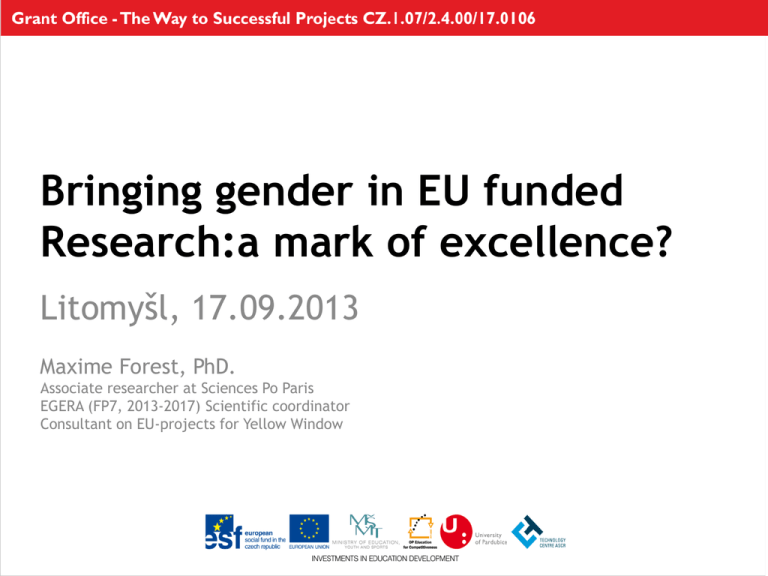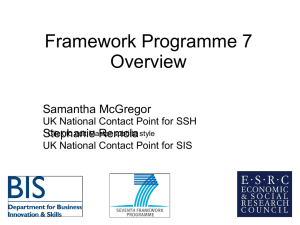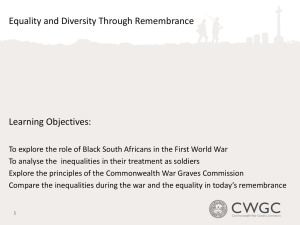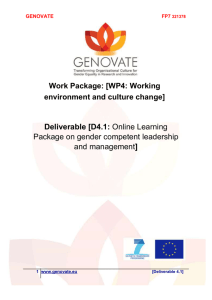
Bringing gender in EU funded
Research:a mark of excellence?
Litomyšl, 17.09.2013
Maxime Forest, PhD.
Associate researcher at Sciences Po Paris
EGERA (FP7, 2013-2017) Scientific coordinator
Consultant on EU-projects for Yellow Window
Content & objectives
• Introducing basic concepts related to gender in
research and the academia
• Raising awareness on the importance of integrating
gender in research, in particular in EU-funded projects
• Informing participants on gender in FP7
• Supporting structural change in research and the
academia: the example of EGERA
1. BASIC CONCEPTS & FIGURES
Sex or gender?
Sex?
• Sex refers to the biologically determined characteristics
of men and women in terms of reproductive organs and
functions based on chromosomal complement and
physiology. As such, sex is globally understood as the
classification of living things as male or female.
Gender?
• Gender refers to the social construction of women and
men, of femininity and masculinity, which varies in
time and place, and between cultures.
From sex differences to
gender inequalities
• The problem is not the difference between men and
women as such, but the difference in how they are valued
• This affects the distribution of boys and girls across
disciplines and curricula, later the distribution of men and
women both horizontally (areas) and vertically (in terms
of distribution of incomes, power and visibility)
• There are still structural inequalities (including
segregation and discrimination) between men & women,
notably in research and higher education, although those
vary across EU member states
Gender inequality in research
• Detailed statistics are released by the EC in She Figures
2012
From the 2012 issue, it notably arises that:
In 2010, female PhD graduates equaled or outnumbered
men in all broad fields of study, except for science,
mathematics and computing (40%), as well as engineering,
manufacturing and construction (26%).
On average, women represented 40% of all researchers in
the Higher Education sector, 40% in the Government
Sector and 19% in the Business Enterprise Sector
The “leaky pipeline”
Coined to address the situation of women in STEMs, this
metaphor refers to the fact that in many fields, women
disappear as they move up the career ladder.
Women’s academic career remains characterized by
vertical segregation: the proportion of female students
(55%) and graduates (59%) exceeded that of male
students, but men outnumbered women among PhD
students and graduates. Furthermore, women represented
only 44% of grade C academic staff, 37% of grade B
academic staff and 20% of grade A academic staff.
Source: She Figures 2012
The “glass ceiling”
In 2010, on average throughout the EU-27, 15.5% of
institutions in the Higher Education Sector were headed
by women, and 10% of universities had a female rector.
On average, 36% of board members were women in 2010
Women are even more strongly under-represented in the
field of science and engineering: they account for 38% of
PhD students, but only 23% of grade B and 11% of grade A.
The proportion of women among full professors is also the
lowest in engineering and technology, at 7.9%.
Source: She Figures 2012
Gender equality in EU perspective
• Individuals of both sexes are free to develop their
personal abilities and make choices without the
limitations imposed by strict gender roles. The
different behaviours, aspirations and needs of women
and men are considered, valued and favoured equally.
A dual-track approach to gender equality:
• Gender mainstreaming (horizontal approach):
Integrating a gender perspective into the mainstream
• Specific actions (vertical approach) still needed:
gender-specific legal provisions/projects/policies
Gender equality in EU perspective
Gender equality is a principle of the European Union,
anchored in EU treaties since the Treaty of Amsterdam
(1997) and enforced through specific EU directives
adopted since the mid-1970s.
EU Legal provisions, to be implemented by member
states, are grounded into the principles of:
equal treatment (since 1975) and:
non-discrimination (since 2000)
2. GENDER IN RESEARCH
EC on gender
in research projects
Fostering women’s participation:
As researchers
As evaluators
Addressing women’s needs as much as men’s
Developing research on gender issues, also in STEMs
Participation of women
in research
• Include female researchers in teams at all levels
Also in leadership positions/Among grant beneficiaries
Prevent gender bias in
recruitment/evaluation/appraisal
•
Offer gender sensitive working conditions and culture
Equally value the work of male/female team members
Create gender-friendly work environments
Prevent sexist language and/or sexual harassment
Fix the “Leaky pipeline”!
Gender dimension
of research
• Consider gender as a key analytical and explanatory
variable in research
Gendered behavioural patterns (addiction, physical and
psychological risks, typology of jobs)
Ergonomics, morphology
Distribution of power/income/responsibilities…
• Devote research resources to specific gender research
Develop cross-disciplinary gender studies
Develop knowledge on gender in all research areas
Gender in Research
The gender-sensitive research cycle
Checklist for gender in research
• Equal opportunities for women and men in research
– Gender balance in the team
– Working conditions
– Manage and monitor gender equality
• Gender in the research content
– Research ideas phase
– Proposal phase
– Research phase
– Dissemination phase
European Charter for Researchers
and Code of Conduct for the
Recruitment of Researchers
Strengthen women’s participation:
–
Improve attractiveness
–
Create conditions for more sustainable careers
European Charter for Researchers
Code of conduct for recruitment:
The business case
Excellent research needs gender equality (efficiency)
Investing in equal opportunities for men and women:
• stimulates the constitution of better performing teams
• allows you to get the best talent from the whole pool
Excellent research needs a gender perspective (quality)
A gender-sensitive approach to the research content:
• Allows your research to be of a higher quality
• Makes it valid for a larger group of end-users
3. GENDER IN FP7
Legal base for Gender in FP7
•EC treaties: Gender Equality
•FP7: “The integration of the gender dimension and
gender equality will be addressed in all areas of
research”
Decision No 1982/2006/EC of the European Parliament and
of the Council of 18 December 2006 concerning the
Seventh Framework Programme of the European
Community for research, technological development and
demonstration activities (2007-2013)
Gender in FP7
•
Target of 40% female participation
•
Option for project holders to promote gender equality
and to address gender aspects in a specific work
package or task within a work package
•
Specific project calls under Science in Society to
promote structural change in favour of gender equality
in research and the academia, both in terms of women’s
participation and appraisal and research content
INTEGER, STAGES, EGERA…
FP7 guide for applicants
"You may give an indication of the sort of actions that
would be undertaken during the course of the project to
promote gender equality in your project, or in your field of
research (…) They could include actions related to the
project consortium (e.g. improving the gender balance in
the project consortium, measures to help reconcile work
and private life, awareness raising within the consortium)
or, where appropriate, actions aimed at a wider public
(e.g. events organized in schools or universities).
(Maximum length for section 5 – one page)"
Gender in FP7 proposal
•
•
•
•
•
B1: Scientific/Technical Quality (Evaluation Criterion)
B2: Implementation (Evaluation Criterion)
B3: Impact (Evaluation Criterion)
B4: Ethical Issues (Not an Evaluation Criterion)
B5: Consideration of Gender Aspects (Not an Evaluation
Criteria (B5 only exists in proposals for CPs and NOEs (larger
projects)
FP7 guide for applicants
“The negotiations will also deal with gender equality
actions, and, if applicable to the project, with gender
aspects in the conduct of the planned work, as well as the
relevant principles contained in the European Charter for
researchers and the Code of Conduct for their recruitment.”
Gender in FP7
negotiation guidance notes
“Sex and / or gender are relevant variables in many
research fields and generally referred to as the gender
dimension of the research content. When human beings are
involved as research subjects or users, and in training or
dissemination activities, gender differences may exist.
These must be addressed as an integral part of the research
to ensure the highest level of scientific quality (…)
It is easy to understand that sex and gender are variables
that must be addressed when considering health research
but it might be less easy to understand that gender could
also be an important factor in, for example, aeronautical or
energy research.“
Gender in FP7
negotiation guidance notes
“As a guideline, wherever human beings are involved in
the research, for example as consumers, users and
patients, or in trials, gender will be an issue and should
be considered and addressed.”
• mandatory reporting on workforce statistics
• mandatory reporting on gender aspects (and other horizontal
project-related issues) as a compulsory deliverable at the end
of the project
4. EGERA: a project in motion
EGERA: a project in motion
Effective Gender Equality in Research and the Academia:
3,3€ million, 4 years long project funded at 70% by the EC.
8 partner institutions in 7 EU member states + Turkey.
Human/social sciences, STEMs, Earth sciences represented
Big (UAB Barcelona, METU Ankara), medium (Sciences Po
Paris, Radboud Nijmegen, Antwerp University) and small
(CVGZ Brno, Vechta Universität) research institutions.
Gender equality action plans and gender training schemes
implemented in each partner institution
EGERA: a project in motion
Gender Equality Action plans include measures on:
Creating gender-sensitive work environments, including
recruitment, work-life conciliation, prevention of sexual
harassment or sexist language…
Challenging gender bias in evaluation and promotion
Mainstreaming gender knowledge across research areas
and academic curricula
Developing research on gender issues
Promoting a culture of equality throughout the institution










